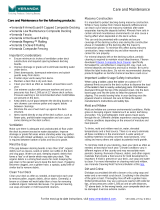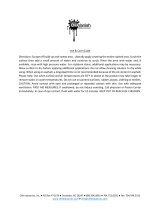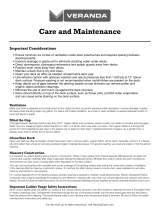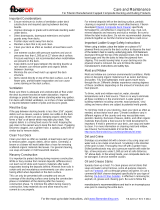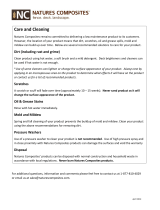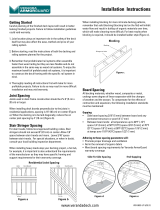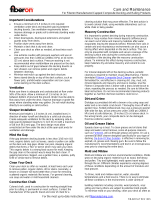
Care and Maintenance
Veranda® ArmorGuard® Decking and Railing and Veranda Composite Railing
For the most up-to-date instructions, visit www.verandadeck.com. VER-0034-LIT Rev C 0713
Important Considerations
Ensure minimum six inches of ventilation under deck
substructure and required spacing between decking
boards.
Improve drainage or grade soil to eliminate standing water
under decks.
Direct downspouts, downspout extensions and splash
guards away from decks.
Position dryer vents away from decks.
Maintain a deck that is dry and clean.
Clean your deck as often as needed, at least twice each
year.
Use extreme caution with pressure washers and use at
pressures less than 1,500 psi at 12" above deck surface.
Pressure washing is not recommended when mold/mildew
are present on the deck.
Keep debris out of gaps between the decking boards so
rain showers can remove pollen and organic debris
between cleanings.
Minimize the use of wet mulch up against the deck
structure.
Items stored directly on top of the deck surface, such as
flower pots, prohibit water evaporation and can cause
some staining on the deck surface.
Ventilation
Make sure there is adequate and unobstructed air flow under
the deck to prevent excessive water absorption. Improve
drainage or grade flat areas where standing water may gather.
For decks with limited ventilation, six inches of clear ventilation
is required between bottom of joists and fascia to grade.
Mind the Gap
If the gap between decking boards is less than 3/16", organic
debris such as leaves, seeds or pollen can settle on the deck
and clog gaps. Water can pool, steeping organic debris that
forms a “tea” or of tannin which may stain your deck. This
organic debris is a strong food source for mold. Keeping the
gap clean is the easiest way to keep the deck clean. If gapping
becomes clogged, use a garden hose, a spatula, putty knife or
similar tool to remove debris.
Clean Your Deck
Clean your deck as often as needed, at least twice each year
to remove pollen, organic debris, dirt or stains. Generally, a
broom or a blower will work better than a hose for removing
scattered organic materials like leaves. For general cleaning,
use soap and water or mild household cleaners.
Masonry Construction
It is important to protect decking during masonry construction.
White or hazy residue from mineral deposits (efflorescence)
can leach out of stone and masonry materials after water
evaporates leaving the deposits behind. Minerals from soils in
certain arid and mountainous environments can also cause a
hazing affect when deposited on the deck surface.
This can only be prevented with complete and secure
coverage of the decking surface area during the construction
phase or installation of the decking after the masonry
construction phase. To minimize this affect during masonry
construction, keep materials dry and allow masonry and
cement to cure properly.
For mineral deposits left on the decking surface, periodic
cleaning is required to maintain visual attractiveness. Fiberon
developed Fiberon Composite Deck Cleaner specifically
formulated for, and effective in cleaning dirt, clay, mud, soil,
mineral deposits and masonry and stucco residue. Be sure to
follow the label instructions. Do not mix recommended cleaning
products together as harmful chemical reactions could occur.
Important Ladder Usage Safety Instructions
When using a ladder, place the ladder on a piece of ¾”
plywood firmly secured to the deck surface to disperse the load
of the ladder’s feet to nearby underlying joists. Drill fasteners
downward through the top of the plywood sheet, into the deck
board gaps and into the joists to keep the plywood from
slipping. This avoids leaving holes in your decking once the
plywood sheet is removed. Be sure to follow the ladder
manufacturer’s instructions and safety tips.
Mold and Mildew
Mold and mildew are common environmental conditions. Molds
grow on decaying organic material such as wood, leaf decay
and pollen. Tiny and lightweight, mold spores travel easily
through the air. Different climates experience varying degrees
of these conditions depending on the amount of moisture and
heat present.
To thrive, mold and mildew need air, water, elevated
temperatures and a food source. There is no way to eliminate
all these conditions in the environment. A wide variety of
building materials including concrete, wood products, vinyl
siding and many others are subject to potential mold growth.
To minimize mold on your decking, clean your deck as often as
needed, at least twice each year. Climate conditions vary in
different regions of the country and may necessitate more
periodic cleaning. Removal of leaves, debris, and other organic
materials that provide a food source for mold development is
important. If mold is present on your deck, use soap and water
to clean. For more information on cleaning mold and mildew,
see Veranda Cleaning Mold Technical Bulletin at this link.
Dirt and Grime
Dislodge accumulated dirt with a broom or by using soap and
water and a non-metal scrub brush. Scrubbing in the direction
of the grain is best. Thoroughly rinse off with a garden hose.
Skilled professionals may use a pressure washer with wide fan
tips, at low pressures under 1,500 psi and at safe distances,
12” above deck. In the wrong hands, your composite deck can
be damaged. Exercise extreme caution.
Oil and Grease Stains
Speedy clean up is best. To clean grease and oil stains that
soap and water cannot remove, some all purpose cleaners,
such as Fantastik, will cut through grease and grime. Or use a
commercial deck cleaner designed specifically for your type of
decking. De-Solv-It Citrus Solution is effective in removing tar,
asphalt, oil, grease and chewing gum. Be sure to follow the
manufacturer’s recommendations and test in an inconspicuous
area prior to cleaning the entire deck.



